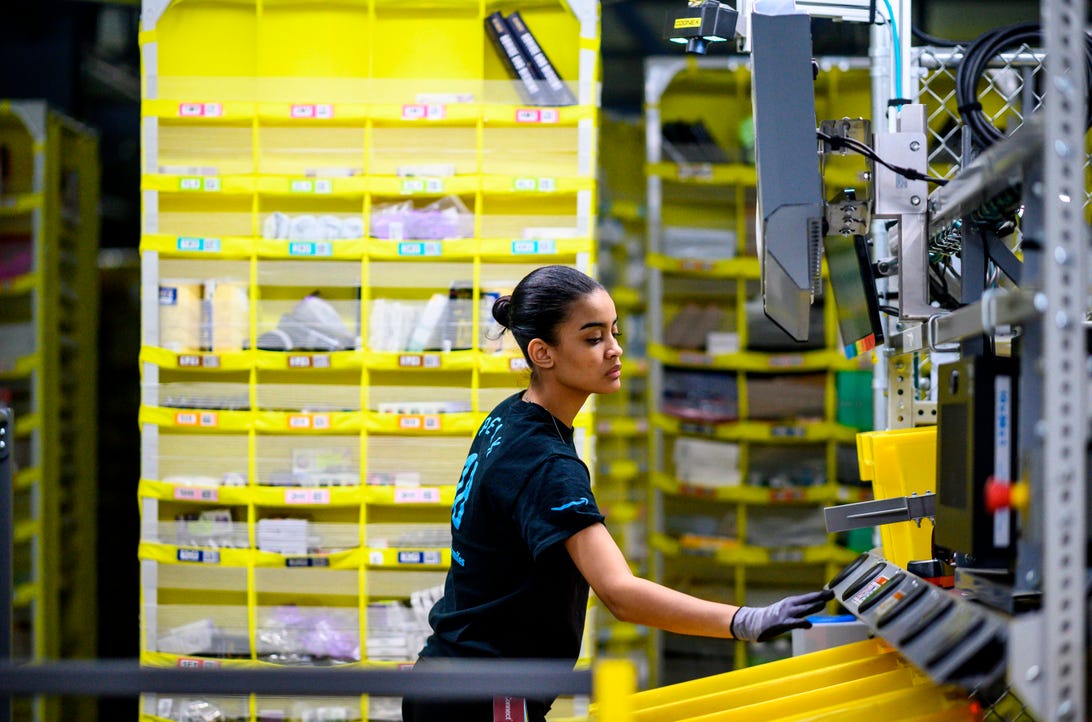
Amazon workers in Staten Island are poised to approve the first US labor union in the company’s history. A union effort in Alabama didn’t get enough votes, based on preliminary results.
Getty ImagesA day of vote counting in two separate Amazon union elections on Thursday showed contests headed in different directions, but there are no final results in the historic organizing movements.
Warehouse workers in Bessemer, Alabama, appeared to vote not to join the Retail, Wholesale and Department Store Union for the second time in a year, according to unofficial results of 875 yes votes to 993 no votes. However, final results won’t be certified until 416 challenged ballots are resolved. Meanwhile, the fledgling Amazon Labor Union finished the day with an unofficial lead of 1,518 yes votes to 1,154 no votes in its bid to represent Amazon warehouse workers in Staten Island, a borough of New York City. It’s unclear how many more ballots remain to be counted or how many contested ballots may need to be resolved after the vote.
A win in New York would mean the first US labor union in Amazon’s history.
Amazon didn’t respond to a request for comment. At a press conference, RWDSU president Stuart Appelbaum said the union would fight to make sure every valid ballot was counted. Regardless of the outcome, he said, this wasn’t the end of the labor movement’s efforts to organize Amazon workers.
“Workers here have shown what is possible,” he said. “They have helped ignite a movement.”
The tallies, conducted by the National Labor Relations Board, come after more than a year of organizing and campaigning at the separate warehouses and are part of a larger labor push at the e-commerce giant. Amazon workers in other locations have engaged in direct labor actions, walking out over demands for raises, paid sick time and the right to keep phones with them at work in case of emergency. Employees at other companies are also considering unions, with workers from more than 150 Starbucks stores filing for union elections and nine stores voting to join Workers United.
Labor experts said the odds were against the unions in both elections. In Staten Island, organizers didn’t get support from more than 50% of workers before requesting an election, filing a petition that simply met the legal requirement that 30% of workers sign on. Not only that, but an earlier petition filed by the union didn’t clear the 30% mark. Andrew MacDonald, a labor lawyer at Fox Rothschild, said unions typically want more than half because they expect to lose support as the vote nears.
“The increase from less than 30% at the time of filing for the election to even having a lead after half of the count is over is unprecedented, at least in recent times,” MacDonald said.
Amazon workers face a unique challenge in forming unions. While Amazon has tried to cultivate an image of striving to be the best employer in the world, it demands long hours and a highly monitored, fast pace of work at its warehouses, leaving little time for chatting among workers. It also has a uniquely high turnover rate, meaning workers who support a union today may be gone tomorrow.
Finally, the size of each potential bargaining unit, or a group of employees who must collectively decide whether to accept representation from a union, is very large at Amazon warehouses. More than 6,100 workers received ballots in Bessemer. The Starbucks stores that have unionized each had a staff of one or two dozen.
“Successful organizing requires one-on-one conversations with every worker,” said Rebecca Givans, an associate professor of labor relations at Rutgers University. “This means that larger workplaces need larger organizing committees, and they need to reach many more shifts and areas of the workplace in order to organize enough people successfully.”
The Amazon Labor Union was formed by current and former Amazon workers following workers’ efforts in early 2020 to demand more COVID-19 protections. Workers who were involved in planning walkouts later faced discipline or firing. As the workers moved on to launch an organizing campaign, the new union filed multiple complaints of unfair labor practices against Amazon for retaliation and intimidation, and an NLRB prosecutor made similar allegations.
The union’s potential victory would be a “big deal,” said analyst Michael Pachter of Wedbush. It also makes sense it would take place in New York City.
“In a tight job market (big cities where everyone earns around the same as Amazon pays), union workers will have leverage,” he wrote in an email.
Bessemer workers first voted on whether to join RWDSU in 2021, rejecting the union by a margin of more than 2-to-1. The RWDSU filed a challenge to the election results, and the labor board called for a new election after finding Amazon illegally interfered with the vote by installing a mailbox that looked like a voting booth, potentially misleading employees into thinking Amazon was running the election and not the NLRB.
On Thursday, RWDSU president Appelbaum said the union believed Amazon acted illegally in this election, too, which could lay the groundwork for another challenge. He said an in-person election would have been a better method because the mailbox incident had tainted the vote-by-mail process for the warehouse workers. Ballots for the second vote went out in the mail in early February, and workers had until March 25 to mail them back.
Workers in Staten Island voted in person over a period of six consecutive days ending on Wednesday. The count will resume on Friday morning.


